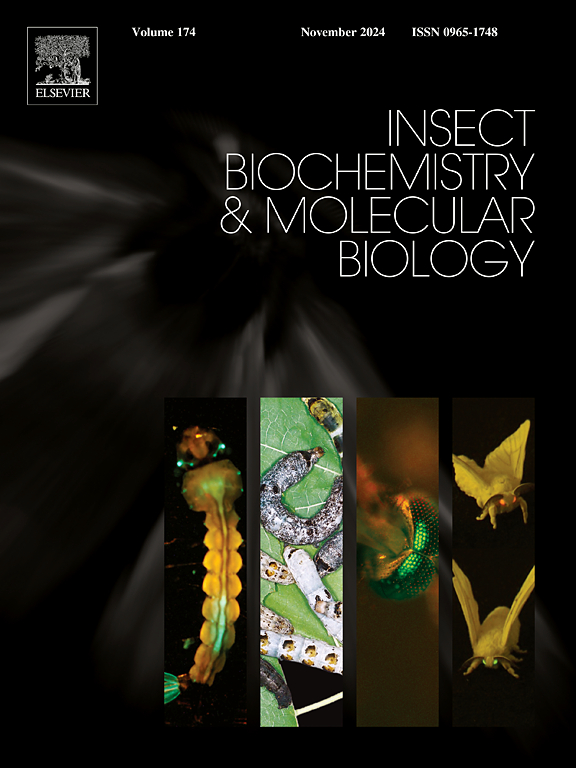Identification of ISG homologous genes in silkworm and revelation of BmNFIL3 inhibition of BmNPV proliferation through regulation of BmRelish transcription
IF 3.7
2区 农林科学
Q2 BIOCHEMISTRY & MOLECULAR BIOLOGY
引用次数: 0
Abstract
It is generally believed that no functional antiviral pathway exists in insects, that is homologous to the interferon signaling system. However, we have previously identified an interferon-stimulated gene (ISG) homologous gene, BmCH25H, in the silkworm and revealed that BmCH25H relied on its hydroxylase activity as an antiviral effector. Therefore, we speculate that there may be additional ISG homologous genes in the silkworm genome, some of which may play an antiviral role. In this study, based on knowledge on ISGs in mammals, 135 ISG homologous genes were identified in the silkworm genome using gene homology sequence alignment and conserved domain matching methods. Among these ISG homologous genes in the silkworm, we conducted in-depth research on an important immunological transcription factor, nuclear factor interleukin 3 regulated (NFIL3). Our results found that BmNFIL3 could inhibit the proliferation of Bombyx mori nucleopolyhedrovirus (BmNPV). Furthermore, we confirmed that the NFκ-B-related transcription factor BmRelish was regulated by BmNFIL3 and that its induction after BmNPV infection was mediated by BmNFIL3. More importantly, we demonstrated that BmNFIL3 relied on BmRelish for its anti-BmNPV effects. This study represents the first systematic identification of ISG homologous genes in invertebrates and also constitutes the first report that NFIL3 has antiviral effects in insects. These findings will provide new perspectives for the further understanding of antiviral immunity in insects.

家蚕ISG同源基因的鉴定及BmNFIL3通过调控bm津津转录抑制BmNPV增殖的揭示
一般认为昆虫体内不存在与干扰素信号系统同源的功能性抗病毒途径。然而,我们之前已经在家蚕中发现了干扰素刺激基因(ISG)的同源基因BmCH25H,并发现BmCH25H依赖于其羟化酶活性作为抗病毒效应。因此,我们推测家蚕基因组中可能存在额外的ISG同源基因,其中一些基因可能具有抗病毒作用。本研究在了解哺乳动物ISG的基础上,利用基因同源序列比对和保守结构域匹配方法,在家蚕基因组中鉴定出135个ISG同源基因。在家蚕的这些ISG同源基因中,我们对一种重要的免疫转录因子——核因子白细胞介素3调节(NFIL3)进行了深入的研究。结果表明,BmNFIL3能抑制家蚕核多角体病毒(BmNPV)的增殖。此外,我们证实了nfκ - b相关转录因子bm津津受BmNFIL3调控,并且BmNFIL3介导了其在BmNPV感染后的诱导。更重要的是,我们证明了BmNFIL3依赖于bm津津子来发挥其抗bmnpv的作用。本研究首次在无脊椎动物中系统鉴定出ISG同源基因,也首次报道了NFIL3在昆虫中具有抗病毒作用。这些发现将为进一步了解昆虫的抗病毒免疫提供新的视角。
本文章由计算机程序翻译,如有差异,请以英文原文为准。
求助全文
约1分钟内获得全文
求助全文
来源期刊
CiteScore
7.40
自引率
5.30%
发文量
105
审稿时长
40 days
期刊介绍:
This international journal publishes original contributions and mini-reviews in the fields of insect biochemistry and insect molecular biology. Main areas of interest are neurochemistry, hormone and pheromone biochemistry, enzymes and metabolism, hormone action and gene regulation, gene characterization and structure, pharmacology, immunology and cell and tissue culture. Papers on the biochemistry and molecular biology of other groups of arthropods are published if of general interest to the readership. Technique papers will be considered for publication if they significantly advance the field of insect biochemistry and molecular biology in the opinion of the Editors and Editorial Board.

 求助内容:
求助内容: 应助结果提醒方式:
应助结果提醒方式:


